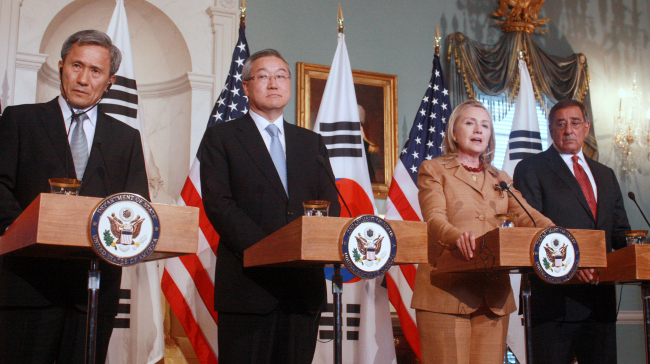Reorganization expected to strengthen deterrence against North Korea on frontline
Seoul and Washington are reportedly considering reorganizing the U.S. Second Infantry Division into a combined unit of both allies to maintain a strong deterrence against North Korea.
The move comes amid lingering concerns that after the transfer of wartime operational control from the U.S. in December 2015, America’s security commitment on the Korean Peninsula could diminish despite Pyongyang’s continuing saber-rattling.
“The South Korean Army and the U.S. Army are in in-depth talks over the measure to turn the 2nd ID into a unit similar to the current Combined Forces Command. Should it be finalized, the 2nd ID will be reorganized into the allies’ combined unit,” a senior military official told local media.
Stressing that the envisioned reorganization would symbolize the long-standing bilateral alliance, the official raised the possibility that the new unit could remain north of Seoul instead of relocating down to Pyeongtaek, Gyeonggi Province, as planned.
“(While remaining north of Seoul as it is now), I think it could play the role of a ‘trip wire,’ meaning the U.S. forces will be automatically involved if North Korea launches an attack on the South,” said the official.
Seoul and Washington are reportedly considering reorganizing the U.S. Second Infantry Division into a combined unit of both allies to maintain a strong deterrence against North Korea.
The move comes amid lingering concerns that after the transfer of wartime operational control from the U.S. in December 2015, America’s security commitment on the Korean Peninsula could diminish despite Pyongyang’s continuing saber-rattling.
“The South Korean Army and the U.S. Army are in in-depth talks over the measure to turn the 2nd ID into a unit similar to the current Combined Forces Command. Should it be finalized, the 2nd ID will be reorganized into the allies’ combined unit,” a senior military official told local media.
Stressing that the envisioned reorganization would symbolize the long-standing bilateral alliance, the official raised the possibility that the new unit could remain north of Seoul instead of relocating down to Pyeongtaek, Gyeonggi Province, as planned.
“(While remaining north of Seoul as it is now), I think it could play the role of a ‘trip wire,’ meaning the U.S. forces will be automatically involved if North Korea launches an attack on the South,” said the official.

The U.S. Forces Korea refused to confirm whether such a reshuffling of the 2nd ID is under consideration.
“We do not discuss operational planning (with the media). But if I may make one comment, the commander said in a March 28 congressional hearing that we continue to work to ensure capabilities are properly positioned on the Korean Peninsula,” USFK spokesperson Kim Young-gyu told The Korea Herald.
Seoul’s Ministry of National Defense also refused to comment on it.
“We don’t officially verify whether it is true or not,” an MND official said, declining to be named.
Reports said that should a new combined unit be created, a two-star U.S. general could head it with a one-star Korean general taking the deputy chief post.
The brigade carries some 30 multiple launch rocket systems with a range of some 45 kilometers, which can be mobilized in case of an armed conflict here to destroy North Korea’s long-range artillery and mechanized units.
After two rounds of high-level defense talks in April 2009, the allies agreed to dispatch the 2nd ID to Camp Humphreys in Pyeongtaek, Gyeonggi Province, by 2015. The plan to relocate its troops in Seoul and north of the capital to Pyeongtaek is proceeding as part of America’s global troop realignment scheme designed for “strategic mobility.”
Conservatives and retired generals in the South said that the relocation could weaken the allies’ deterrence against North Korea’s possible aggression.
They also said it is still premature for Seoul to lead military operations independently in case of an armed conflict on the peninsula, citing North Korea’s asymmetrical arsenal and Seoul’s lack of intelligence, surveillance and reconnaissance assets.
After the OPCON transfer, the South Korean military will lead ground and naval operations with the U.S. taking a supporting role. The three-star commander of the U.S. 7th Air Force will lead aerial operations while Korea’s three-star Air Force operations commander is to take the deputy post of the combined air force.
Established in 1917, the U.S. 2nd ID participated in the 1950-53 Korean War after it was dispatched to the then Far East Command. After the war, the unit returned to the U.S. mainland. It came back to Korea in 1965 after peninsular tensions spiked with North Korea continuing to attempt border intrusions.
There are some 15,000 troops belonging to the division, compared with the total number of American troops here standing at around 28,500.
By Song Sang-ho (sshluck@heraldcorp.com)
-
Articles by Korea Herald








![[KH Explains] How should Korea adjust its trade defenses against Chinese EVs?](http://res.heraldm.com/phpwas/restmb_idxmake.php?idx=644&simg=/content/image/2024/04/15/20240415050562_0.jpg&u=20240415144419)











![[Today’s K-pop] Stray Kids to return soon: report](http://res.heraldm.com/phpwas/restmb_idxmake.php?idx=642&simg=/content/image/2024/04/16/20240416050713_0.jpg&u=)